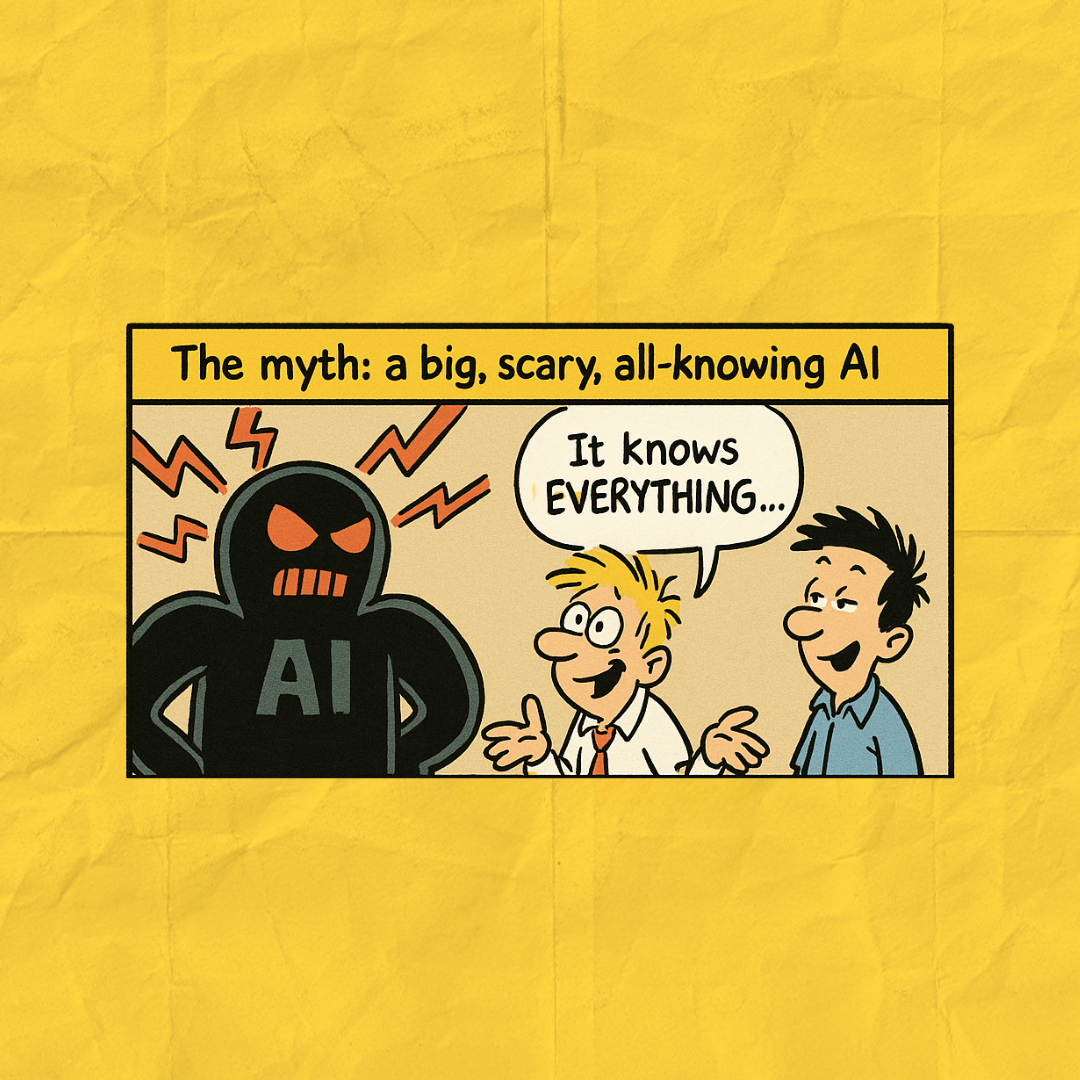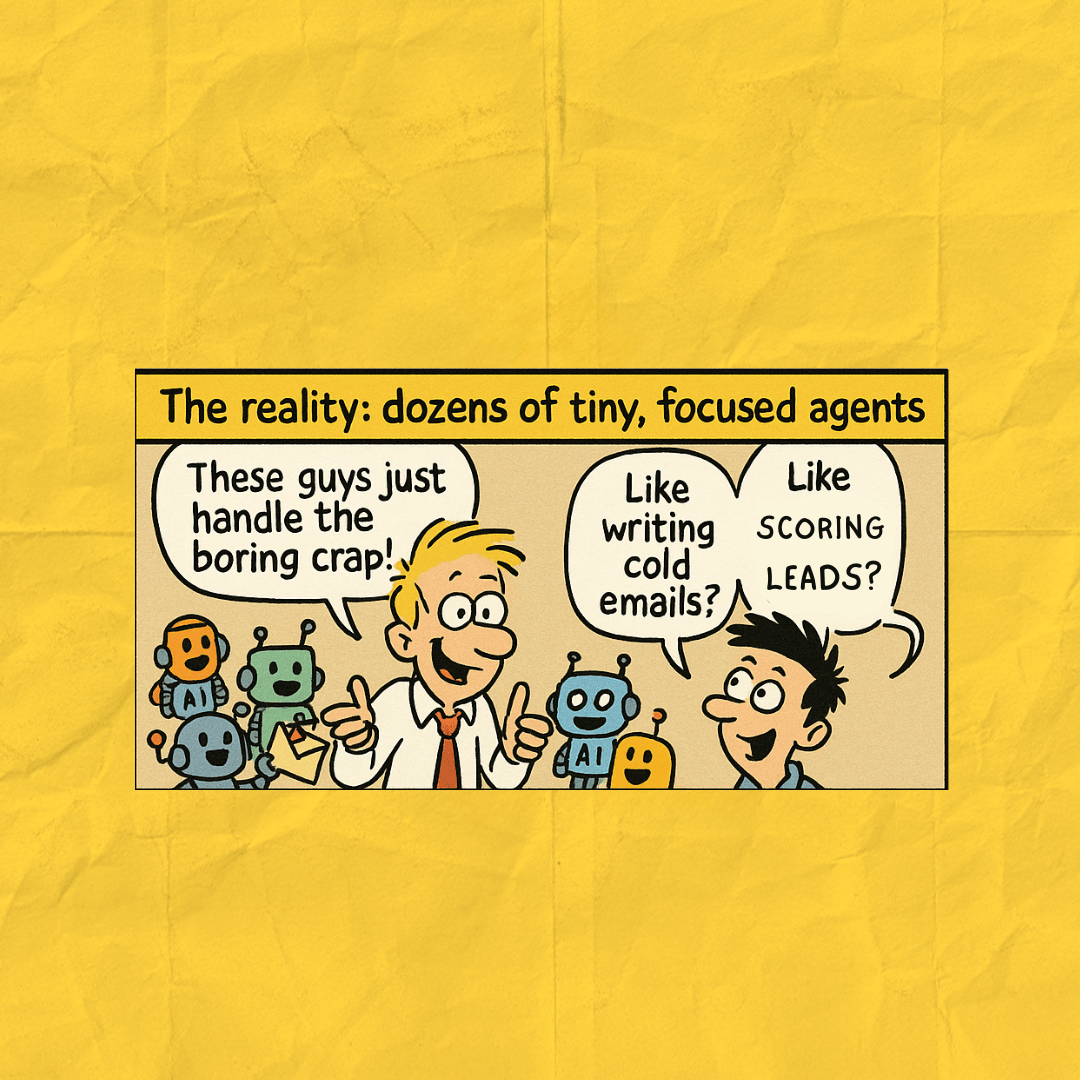- the Weekly Invoice
- Posts
- AI is Smoke and Mirrors
AI is Smoke and Mirrors
The playbook for building a high-performing sales org—one simple AI agent at a time.
The AI revolution in sales isn’t about replacing your team with all-knowing bots—it’s about deploying a thousand tiny, focused agents to do the heavy lifting on tasks you already know move the needle. The biggest misunderstanding about AI leads is that they’re complex, mysterious, or “too much” for your business. In reality, the best AI you can use today is just a smarter, faster version of the rev ops workflows and integrations you rely on already. The sooner you embrace the simplicity, the faster you’ll outpace the competition.
Stop Overthinking AI—Start Winning with Simple, Focused Agents
The Myth of the All-Knowing AI
Let’s get this out of the way:
Most of what you hear about AI in sales and marketing is overhyped. The narrative is that somewhere, your competitor has a single AI running their entire revenue engine—qualifying leads, writing emails, closing deals, and reading the minds of every buyer in the market.
Here’s the truth:
Nobody is doing that.
Not Salesforce, not Google, not the unicorn startup down the street. The real edge today isn’t in deploying a single, all-powerful AI overlord. It’s in unleashing dozens (or hundreds) of small, single-task agents—each laser-focused on a high-impact, repetitive, or time-consuming job.

Why Small AI Agents Work
Think of AI agents as digital interns—each one trained to do one thing well, at scale, and without fatigue. The smaller the task, the easier it is to train, monitor, and trust the output. The results? More consistency, less error, and a compounding effect on your team’s productivity.
Three High-Impact Examples
1. Prospect List Builders
Instead of asking AI to “find all my next customers,” teach an agent to scrape LinkedIn for posts about conference or tradeshow attendance. Suddenly, you have a real-time list of prospects who are active in your space, signaling intent, and likely open to outreach.
2. Qualification Reviewers
Rather than hoping AI will magically close deals, use it to review potential leads’ websites, social content, and recent conversations. The agent can flag which prospects fit your ICP, have engaged with similar offers, or are talking about pain points you solve.
3. Competitive Content Watchdogs
Deploy an agent to monitor your competitors’ blogs, podcasts, and social feeds. The goal isn’t to copy, but to anticipate shifts in messaging or product focus—so your sales team can steer conversations and stay ahead.
The Power of Simplicity: AI as Workflow Automation
If you’ve ever used Zapier, Make, or even a basic CRM automation, you’re already halfway to AI-powered sales. The difference?
AI agents can make decisions based on context and nuance—like interpreting a LinkedIn post or summarizing a sales call transcript.

What Does This Look Like in Practice?
Newsletter Creation:
An agent reviews transcripts from your weekly sales, customer, and advisory calls, identifies the most common topics, and drafts a newsletter outline. (Sound familiar?)Micro-Signal Analysis:
Another agent tracks website visits, then cross-references that with email open rates and recent social engagement. If a prospect’s activity spikes, the agent flags them for a personalized follow-up.No Privacy Headaches:
All of this is done using data you already own—no scraping personal info, no violating privacy laws, no corporate espionage required. Each agent sees only what it needs to complete its task, just like a well-trained intern.
The Secret: Think Like a Sales Manager, Trained Like an Intern
The best sales leaders don’t throw a new hire into the deep end. They give them a clear, repeatable task, coach them to mastery, and then scale up. Your AI agents should be no different.
How to Build Your AI Agent Playbook
1. Identify High-Impact, Repetitive Tasks
What do your reps or SDRs do every day that’s time-consuming but critical?
List building, qualification, competitor monitoring, meeting prep, follow-up sequencing.
2. Design Micro-Agents for Each Task
Don’t ask for the world.
Build or buy agents that do one thing: scrape, summarize, flag, or route.
3. Integrate with Your Existing Stack
Connect agents to your CRM, email, and communication tools.
Use APIs or low-code platforms to streamline handoffs.
4. Monitor, Adjust, and Scale
Just like you’d review an intern’s work, check agent output regularly.
Tweak prompts, retrain on new data, and add more agents as you find new bottlenecks.

Example Playbook:
Agent 1: Scrapes LinkedIn for posts about industry events, updates CRM with new leads.
Agent 2: Reviews website changes and recent blog posts of target accounts, flags those with relevant updates.
Agent 3: Monitors competitor podcasts, summarizes key talking points for weekly sales huddles.
Agent 4: Tracks email open and reply rates, highlights prospects ready for a human touch.
The Compound Advantage: Many Small Wins Add Up
Here’s where the magic happens:
When you deploy dozens of small, focused agents, the cumulative effect is massive.
Your team spends less time on grunt work and more time selling.
Your data gets richer and more actionable with every cycle.
Your sales process becomes more responsive, more personalized, and more scalable.
Busting the AI Myth: You’re Not Behind—You’re Ahead
If you’ve been feeling FOMO because you’re not running an AI-powered sales department, relax. The real winners are the ones who focus on small, practical, and frequent automations. If you can train an intern, you can train an AI agent.
What Not to Worry About
You don’t need a PhD in AI.
Most of today’s best tools are no-code or low-code. If you can write an SOP, you can build an agent.You’re not violating privacy or secrets.
All the workflows described here use your own data, public sources, and standard integrations.You don’t need to “see the forest” right away.
Let your agents handle the trees—one at a time. Over time, you’ll see the bigger picture emerge.
Action Steps: Get Started Today
Pick One Workflow:
Choose a single, high-impact, repetitive task in your sales process.Find or Build a Micro-Agent:
Use off-the-shelf AI tools, or work with your ops team to build a simple agent for that task.Integrate and Test:
Connect it to your CRM or communication stack. Run a pilot, measure the impact, and iterate.Scale Up:
Once you see results, add more agents for other tasks. Document your playbook and share learnings across your team.Celebrate the Wins:
Track time saved, pipeline velocity, and rep productivity. Share success stories to drive adoption.
Closing Thought
The biggest misunderstanding about AI leads is also your biggest edge:
AI isn’t about replacing your team or building an all-seeing robot overlord. It’s about deploying a swarm of small, focused agents—each one making your business a little smarter, faster, and more human at the moments that matter.
So, think smaller.
Execute more frequently.
Tighten your training.
And watch your sales operation compound its wins—one micro-agent at a time.
Got it? Great.
—Grady
I make videos too! If you like the strategy here, you’ll love the execution on Youtube. Subscribe and comment video topics you want to see soon. 👇